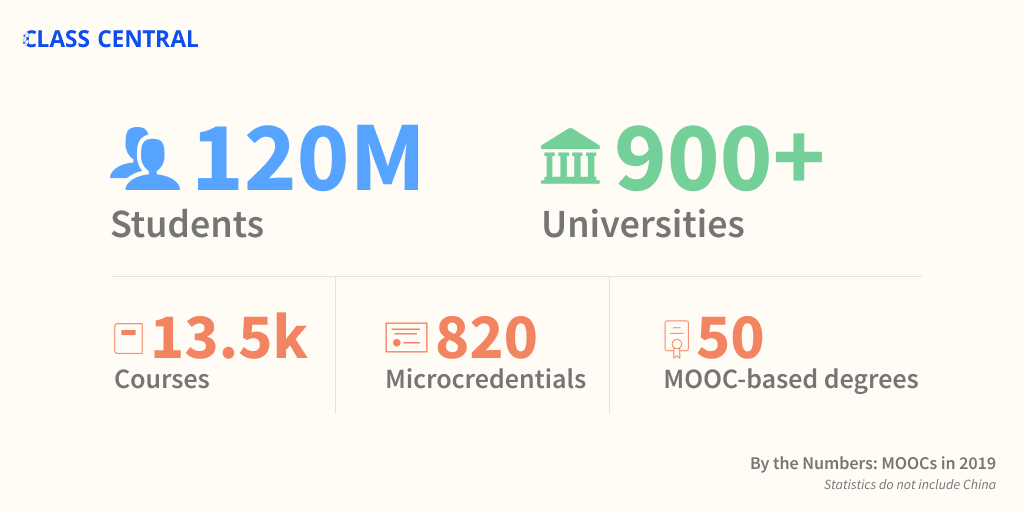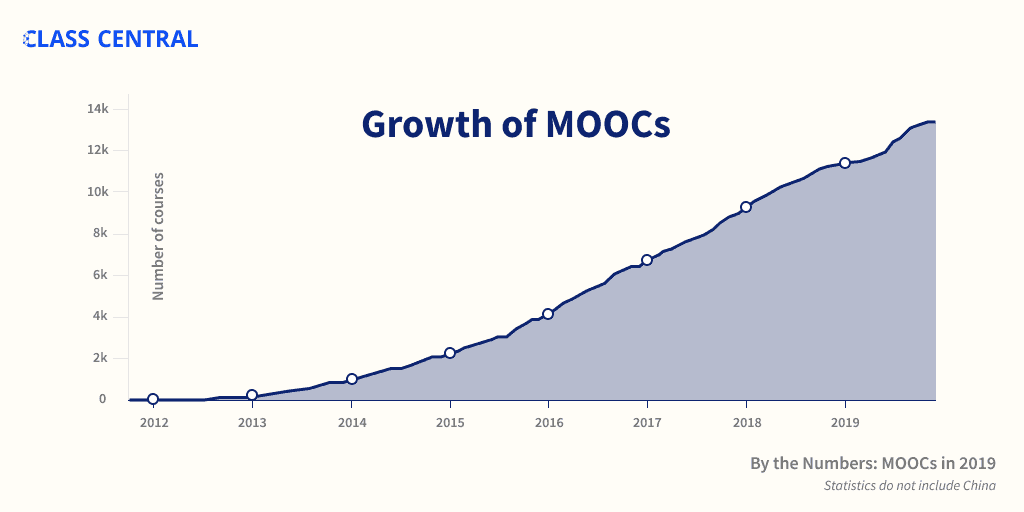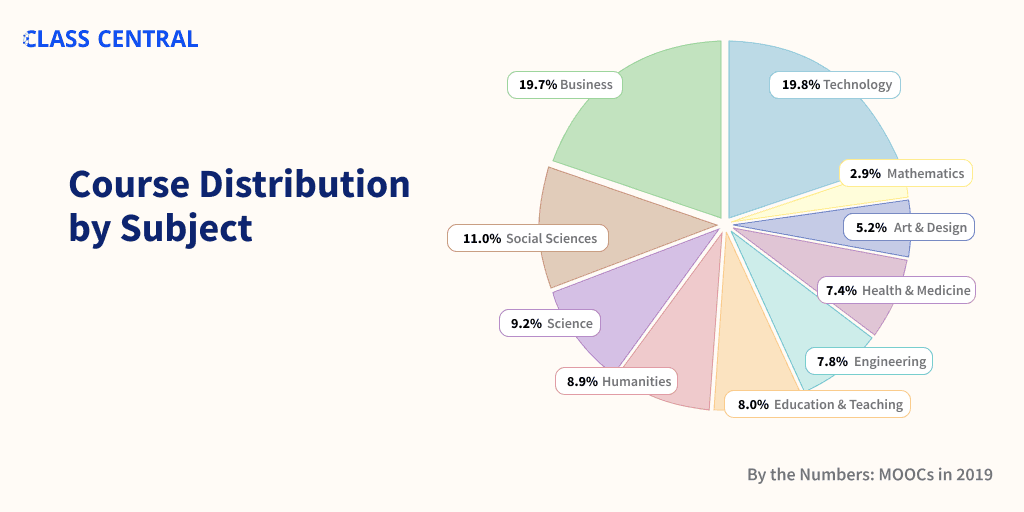By The Numbers: MOOCs in 2019
Now in its eighth year, the modern MOOC movement has reached 120 million learners.

Now in its eighth year, the modern MOOC movement has reached 120 million learners*, excluding China1. In 2019, providers launched over 2,500 courses, 11 online degrees, and 170 microcredentials.
Here’s how the top-5 MOOC providers look like in terms of users and offerings:
| Learners | Courses | Microcredentials | Degrees | |
| Coursera | 45 million | 3,800 | 420 | 16 |
| edX | 24 million | 2,640 | 292 | 10 |
| Udacity | 11.5 million | 200 | 40 | 1 |
| FutureLearn 2,4 | 10 million | 880 | 49 | 23 |
| Swayam 2,3 | 10 million | 1,000 | 0 | 0 |
For Class Central‘s complete analysis keep reading. For our previous years’ analyses, follow the links:
- By The Numbers: MOOCs in 2018
- By The Numbers: MOOCs in 2017
- By The Numbers: MOOCs in 2016
- By The Numbers: MOOCs in 2015
Courses

By the end of 2019, 13.5K MOOCs have been announced or launched by over 900 universities around the world. In 2019 alone, around 2.5K courses were launched by 450 universities.
Online Degrees
| 2017 | 2018 | 2019 | |
| Coursera | 4 | 11 | 16 |
| edX | 1 | 9 | 10 |
| FutureLearn | 4 | 18 | 23 |
In 2018, we saw the top MOOC providers announce a large number of degrees: 30 overall!
I called this the second wave of MOOC Hype and 2018, the year of MOOC-based degrees.
But in 2019, only 11 new degrees were announced, most by Coursera and FutureLearn.
Interestingly, a MOOC-based degree seems to have been either canceled or postponed: edX’s Data Science Master — offered by the University of California, San Diego — isn’t listed on the provider’s page anymore.
The total number of MOOC-based degrees has now grown to 50. This number includes Georgia Tech’s online master’s degree in computer science (OMSCS), which is offered on Udacity and has over 9,000 students.
You can find a comprehensive list of MOOC-based master’s degrees here.
Microcredentials
| Type | Provider | 2018 | 2019 |
| Specializations | Coursera | 310 | 400 |
| Professional Certificate | Coursera | 0 | 13 |
| MasterTrack | Coursera | 3 | 6 |
| Professional Certificate | edX | 89 | 123 |
| MicroMasters | edX | 51 | 56 |
| XSeries | edX | 29 | 40 |
| Professional Education | edX | 62 | 73 |
| Nanodegrees | Udacity | 35 | 40 |
| Programs | FutureLearn | 23 | 32 |
| Academic Certificates4 | FutureLearn | 14 | 17 |
| Programs | Kadenze | 19 | 20 |
The total number of MOOC-based microcredentials has now crossed 800. In 2019, more than 170 new microcredentials of 10 different types have been launched. In 2018, only 120 microcredentials were added.
Subjects

Overall, the distribution of courses across subjects has remained quite similar to last year. Forty percent of courses belong to the categories that are the easiest to monetize: business and technology.
* A previous version of this article, and its banner, said that in 2019, we’d reached 110M MOOC learners. When computing this total, we forgot to account for Swayam’s 10M learners. The correct number is 120M learners.
[1] We decided to leave China out of our analysis this year because, as we learned more about Chinese online education, we realized that the metrics we’d like to present are: (1) sometimes unavailable, (2) sometimes available but impossible to validate to the extent we’d like, (3) sometimes reflect a view too narrow to adequately capture the overall state of MOOCs in China.
[2] For platforms with session-based courses, we counted the total number of distinct courses offered in 2019.
[3] This is the first year that Swayam is included in Class Central’s analysis. This year, NPTEL and Swayam were merged, which is one of the reasons behind the rapid growth of the Indian MOOC provider.
[4] Graduate and Postgraduate Certificates are listed under microcredentials, instead of under degrees.
This article is just one of our 2019 MOOC Roundup Series. Find the whole series here. You’ll discover everything about MOOCs in 2019 — from the most popular classes, to overviews of MOOC platforms developments, to looking at the future of MOOCs.







Beverley Oliver
Hello Dhawal,
thanks for your interesting analysis. I have a question: when you report that “the modern MOOC movement has reached 110 million learners” – are these really 110 million different individuals? or are they possibly a smaller number of people who have registered for multiple MOOCs. In other words, is “learners” the accurate term, or are you counting “registrations”?
Many thanks
Muvaffak GOZAYDIN
I wonder ” how many finishers are ? That is how many received certificate being successful ? “
Muvaffak GOZAYDIN
Beverly
There are multiple registrations as well . I registered 10 courses and I did not finish one .
The most impğortant number is hjow many people finished , and got certificate .
Success is measured by that . But providers, EDX, Coursera do not give that number .
They lose trust on them . They do not know that . Why you hide your success. Are you unsuccessful .
Shah tried to learn this many times , but no avail .
Rachel
Why the report doesn’t include China?
Dhawal Shah
Short answer: It is beyond our capacity right now.
Here is the long answer:
We decided to leave China out of our analysis this year because, as we learned more about Chinese online education, we realized that the metrics we’d like to present are: (1) sometimes unavailable, (2) sometimes available but impossible to validate to the extent we’d like, (3) sometimes reflect a view too narrow to adequately capture the overall state of MOOCs in China.
Thomas
More in depth analysis of attrition rates is published in this article (subscription required).
https://science.sciencemag.org/content/363/6423/130?utm_source=e-Literate+Newsletter&utm_campaign=fd7c2d2185-RSS_EMAIL_CAMPAIGN&utm_medium=email&utm_term=0_deab6fbf84-fd7c2d2185-40282373
Aman Jindal
Sir can you provide MOOCs data related to India only?
Sambhavi
Hi,
The no. of courses in 2019 is 13.5k & that in 2018 was 11.4k (growth of 2.1k). But the article mentions that 2.5k courses were added in 2019. If you could please explain the additional 400 courses that are being considered for the statement on this page.
Thanks
Sambhavi
Hello Dhawal,
Could you please reply to the same?
Thanks
Martha García
Hello Dhawal,
Could I include any graphics in an article including the source?
THanks
Dhawal Shah
Go for it.
Kriti
Hey, how many students from Nepal are enrolled for MOOCs?